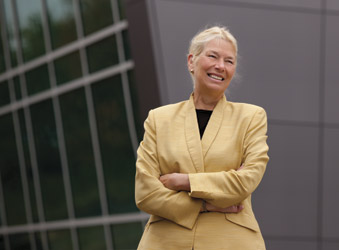I grew up in Wisconsin and attended college and medical school at the University of Wisconsin Madison. I came to Peoria in 1978 to begin my residency in internal medicine at Saint Francis Medical Center. At the time, I expected to return to Wisconsin after completing my three-year residency in internal medicine. However, I met and married Dr. Tom Cusack, a radiologist and native Peorian, in 1981, and we’ve been here ever since! We’ve been happily married for over 30 years, and have seven children and six grandchildren. I’ve always worked full-time. My career path evolved and has included private practice, teaching, administration, hospitalist work, and now, regional dean.
Major Accomplishments of 2011
This has been a great year for the College of Medicine, as several long-term projects are coming into reality.
The first is our new Cancer Research Center. The project’s roots started in 2001 when Dean Rager recruited an internationally renowned leader in cancer research, Dr. Jasti Rao, to lead our Cancer Biology Research Program. Dr. Rao is an exceptional researcher and a hard-working and forceful leader for his department. The $13 million Cancer Research Center will provide Dr. Rao and his team with beautiful, functional new laboratory space and also allow us to recruit additional talented researchers. Our hope is that Peoria will one day be known for the life-saving discoveries made in our building. The modern design of the building highlights the medical school’s cutting-edge research and creates a new and brighter face for the school.
The second big project is the Jump Trading Simulation and Education Center (JTSEC). JTSEC will be one of the most exceptional facilities of this type in the world and will place Peoria at the forefront of innovative healthcare simulation. Simulation is the art of training health professionals in settings that look and feel real, but aren’t. Located at OSF, this joint UICOMP/OSF project uses simulation to improve patient care through education, system redesign and innovation. I believe the programs and projects that occur in the JTSEC building will have a profound effect on healthcare and our community.
The next accomplishments aren’t bricks and mortar, but are equally important and are in education. Working collaboratively with Methodist, we started our psychiatry residency, the first new residency in decades. I believe strongly in the importance of addressing both the patient’s mental and physical health. This residency, under Dr. Ryan Finkenbine’s leadership, will expand our ability to accomplish this. Also, we completed a major revision of our medical school curriculum. This shift to small group, active learning has required a lot of hard work by our many volunteers and salaried faculty. The outcome is increased focus on problem solving and better prepared students.
 UICOMP’s mission statement is “Lead Collaboration to Improve Health.” All our accomplishments this year reflect our collaboration with our affiliated hospitals, community partners, donors, faculty and students. I’m fortunate to have such outstanding people to work with, and am privileged to serve as dean at a time when so many long-term projects are bearing fruit!
UICOMP’s mission statement is “Lead Collaboration to Improve Health.” All our accomplishments this year reflect our collaboration with our affiliated hospitals, community partners, donors, faculty and students. I’m fortunate to have such outstanding people to work with, and am privileged to serve as dean at a time when so many long-term projects are bearing fruit!
What is your secret to maintaining a balance between your work and personal life? I wish there was a secret to maintaining balance. Believe me, if I knew one I would share it! I think of balance like a teeter totter. Sometimes it tips one way, and sometimes the other. It takes constant attention, adjustment and realignment. I think the key things to remember are:
- No one can do everything well at the same time (Superwoman doesn’t exist).
- Some things are more important to spend time on than others—you should not let someone else decide your priorities.
- Be willing to alter your career path and work/home balance when opportunities and/or home needs occur.
- Learn how to say “no.” (My staff will tell you that I haven’t learned that one yet.)
I once told a very hard-working, soon-to-retire physician how much I admired his devotion to his career, which included working incredibly long hours. He replied, “Be careful. You’ll never hear a retired doctor say, ‘I wish I had spent more time at my work.’” I’ve never forgotten that. I love my current job as dean, but I would never have been able to balance it with having young children at home, and I think I would have known better than to try.
What advice would you give to up-and-coming female professionals? Time is the most valuable resource that you have. Once an hour has passed, it can never be recovered. Prioritize what you want to accomplish at home and at work, and then match the time you spend to your priorities. Sometimes we say, “I need to work late because my boss wants me to,” and certainly that’s an important factor. But if that happens consistently and doesn’t match your priorities, then it is time to take the risk of saying “no.” Too often, we spend our time on things that seem urgent but not very important. Delegate what you can. Remember to consciously and explicitly look at your very important, longer-term priorities. Otherwise, the lack of an immediate deadline tends to place these on the backburner.
Is there still a glass ceiling for women in 2011? I think that if you asked almost anyone, they would say that women and men are equally talented and that men and women should have equal pay and employment opportunities. However, the data says that this isn’t what is happening. Women are greatly underrepresented in leadership positions in medical schools, and for the same accomplishments, are less likely to get promoted. Women generally are also less well paid.
I think the problem is that many of us have unrecognized biases. Studies suggest that when we hear adjectives like warm, empathetic and communicative, we pick female candidates. When we hear strong, assertive and commanding, we pick male candidates. Since we associate leadership with “male” characteristics we tend to unconsciously pick male candidates over female ones. Recognizing the power of these unconscious biases is the first step to accomplishing an equitable work environment. Unfortunately, because the biases are unconscious, they are particularly difficult to change, so I think this problem will resolve slowly. In the meantime, I think it is important for leaders to actively mentor their faculty so that each of them can reach her or his potential. iBi






